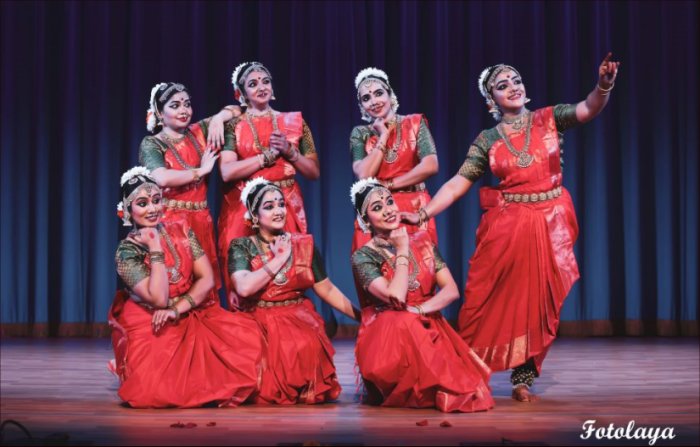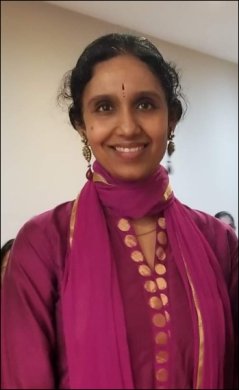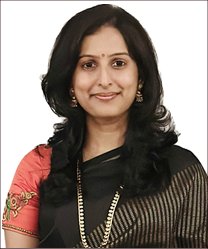
|   |

|   |
Margazhi arrives early in New Jersey - Dr. Smruthi Jayasundar e-mail: smritya.silambam@gmail.com November 13, 2023 A typical Friday evening turned into an enriching experience for the Indian classical arts enthusiasts gathered at the Sri Venkateswara Temple's Cultural Center, NJ on October 13, 2023. The New Jersey rasikas were treated to an evening of scintillating Bharatanatyam - 'Nritya Navaneetam' by the Nartaki ensemble comprising of senior, established dancers and teachers from New Jersey - Nirupamaa Chandrasekaran, Jayalakshmi Radhakrishnan, Gayathri Suswaram, Anupama Sridharan, Shobitha Arun, Deepthi Gad and Sujata Chakraborty from Denver, Colorado. What made it even more special was the accompaniment of these talented and hard-working dancers by an august live orchestra comprising of the mellifluous Srikanth Gopalakrishnan on vocal, the immensely experienced Ramya Ramnarayan on nattuvangam, senior percussionist and incredible rhythmist Murali Balachandran on mridangam, the skillful Deepa Venkat on the violin, the ever impressive N. Visveshwaran on the flute and the talented young emerging vainika Sumedha Jayaraman. While the presence of a live orchestra is a certainty for arangetrams these days, it was refreshing to see this confluence of experienced dancers and musicians enhance each other, truly providing the audience with a memorable feast to both the eyes and ears. The Nartakis presented the traditional Bharatanatyam Margam adapted to a group format with an engaging repertoire. They commenced with a vibrant Pushpanjali in ragam Saraswati set to adi talam composed by veteran Bharatanatyam Guru Madurai R. Muralidharan in his quintessential style. The dancers burst on stage in a hue of red with striking nritta, formations and poses well complemented by the experienced orchestra, making for a fitting start to the evening's proceedings. This was followed by Tanjore Quartet's Jathiswaram in Arabhi ragam set to adi talam, a Kalakshetra staple performed competently by the experienced dancers. Jathiswaram is a test to any dancer's stamina and requires skill, complete grasp over nritta and effortless rendering to create a seamless viewing experience for the audience. Each dancer in the Nartaki ensemble, backed by years of training and a solid foundation, combined with intelligent and engrossing choreography successfully created this experience for the audience. The Jathiswaram was followed by a beautiful Sharadha Kauthuvam in ragam Valachi set to adi talam soulfully composed by the vocalist Srikanth Gopalakrishnan. The crowning piece of the evening's margam was "Velanai kaanbom", a varnam in Khamas ragam set to adi talam, composed by G. Lalitha and Ranganayaki Jayaraman. This piece was a perfect synchronization of bhavam, ragam and talam as the dancers commendably expressed their love and devotion for Lord Karthikeya in their search to get a glimpse of his divine darshan.  Nartaki ensemble The second half of the evening's recital witnessed duet performances of the dancers treating us to nuanced abhinayam. "Nee uraipai Hanumaane", a keerthanam exploring the bhakti rasa through an enjoyable conversation between the devoted Hanuman and Lord Rama was skillfully presented by Shobitha Arun and Anupama Sridharan. "Kuru yadhunandhana", the last of Jayadeva's ashtapadis celebrating the immortal love of Lord Krishna and Radha was delightfully presented by the expressive duo Jayalakshmi Radhakrishnan and Nirupamaa Chandrasekaran, capturing vividly the essence of the composition and the poet's intent. Swati Tirunal's "Kamini mani," a conversational javali best showcased dancers Gayathri Suswaram and Deepthi Gad's strength in abhinaya as they interlaced as the covert sakhi and the all-knowing nayika. Sujata Chakraborty's "Gahana kusuma kunja", a beautiful cluster of poems by Rabindranath Tagore and Sounak Chattopadyay with dance arrangement by Ramya Ramnarayan, added a fine dimension to conclude the abhinaya segment. A brisker pace and perhaps an abhinaya piece catering to the younger audience may have elevated the recital further. The evening ended with Lalgudi Jayaraman's vibrant Maand thillana in praise of Goddess Kamakshi followed by the Mangalam. This was indeed the perfect way to usher in the Navaratri weekend. I walked out a very content rasika that evening like several others in the audience, wishing the Nartaki ensemble many more such opportunities to continue enriching their artistic pursuits. Their return to the performance stage after a hiatus was telling of their passion and commitment. The more they perform together, minute aspects like coordination, stage alignment and cohesiveness will fall in place effortlessly. More power to the Nartakis in their effort to spread the fragrance of this awe-inspiring art form. This was a worthy start! As I headed out, I ran into eminent Guru Ramya Ramnarayan, our accomplished nattuvanaar for the evening and a prominent figure in USA's Bharatanatyam milieu. A quick hello soon turned into a meaningful and insightful conversation on the relevance of Bharatanatyam in America and her journey in carving a niche for this art form on U.S. soil. Here's what she had to say. When you moved to the U.S. in the 1990s, how did you cope with the lack of a strong Indian classical arts community, an ecosystem that you grew up in India? How has it evolved over the years? Like most students of Indian classical arts at the time, I grew up in a Guru-Sishya parampara, breathing and living Bharatanatyam and gaining knowledge through osmosis by virtue of a well-established and thriving cultural arts scene in Chennai. There indeed was a vacuum when I immigrated to the U.S., given the existence of a meagre diaspora in the early 90s. I remember grasping every opportunity that came my way to stay connected to a dance form that was a way of life for me. Keeping close contact with my peers in India helped me stay inspired, uphold the standards of this art form and find my calling. Baby steps marked by will, determination and my eternal love for Bharatanatyam have brought me to where I am today and enabled me to contribute in a meaningful manner to this large ocean. The last decade has seen an outburst of Indian population, thus attracting several dancers as well to move to the tri-state area. This is reflected in the significantly evolved landscape of Indian classical dances, their representation and awareness in the U.S.  Ramya Ramnarayan Being a torch bearer to the Indian arts community in the U.S., what is your advice to the new generation of students learning this art form here? My request is to watch as many artistes as possible, beyond the visiting artistes hosted by one's own dance school. This will be a gamechanger in sustaining quality and elevating standards of Indian classical arts in the US. Teachers must encourage and emphasize this component as part of the curriculum and insist their students to prioritize, immerse and value this vital experience. Watching dance is as important as learning, and is essential to a holistic training. The more we watch and observe, the more we learn and when it is our time to shine on stage, we will reap the benefits of the knowledge gained through watching other artistes. We are in that way blessed to have several accomplished artistes (dancers and musicians) visit us year round from all over the globe. Music knowledge and appreciation is integral to Bharatanatyam, so allow yourself to soak in the rich music and dance culture and all they have to offer. Recent years have seen numerous teachers of Indian classical arts emerge in U.S. Do you see that as a boon or bane? Definitely a boon. Bharatanatyam is constantly evolving and reinventing itself like any other art form. To have more artistes, teachers, practitioners and emerging performers within the diaspora is always invigorating. More the merrier, so long as they impart the art form with sincerity and integrity and uphold the standards for the next generation to imbibe. How can we make Indian classical arts mainstream in the U.S.? Mainstream can be taken in two ways; one is to make something commercial and the other is to bring it into prominence. Hence I shall answer from both perspectives. Bharatanatyam is fine arts, a highly nuanced codified dance form with divinity and sanctity as its forte. It is an art form to be savored, as it creates a unique, refreshing and almost meditative experience for the viewer and aids them to look inward and find their calm amidst the chaos. Just like western classical forms like Opera and Ballet are not for all taste buds, but yet they have a very special place in their own right, similarly it is okay for Bharatanatyam or any classical fine arts to find its own niche audience. It is important to educate, nurture and expand the audience's interest and understanding of all classical art forms. Fine arts is indeed food for the soul and can have considerable impact in crafting a sensitive society. Putting the spotlight on Bharatanatyam or Indian classical arts education in spaces where young America engages like schools and colleges will play a huge role in bringing this art form into prominence and making it relevant to future generations. This kindling of interest, captivating a section of the society and expanding horizons has certainly been happening for Bharatanatyam in the US, albeit in pockets, but I am hopeful of it going beyond in a thriving fashion. It will require selfless dedicated artistes and practitioners to achieve this in a sustainable manner and I am optimistic of embracing this soon. I leave the readers with words of my revered Guru Prof. Sudharani Raghupathy as food for thought - "Artistry is admired because it looks 'effortless' after constant practice".  Dr. Smruthi Jayasundar, a senior disciple of Prof. Sudharani Raghupathy, is a stem cells scientist, Bharatanatyam dancer and teacher. She is the founder and artistic director of Smritya Silambam Dance Academy, NJ. |